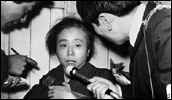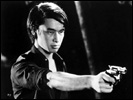Live Today, Die Tomorrow
- Year
- 1970
- Original title
- Hadaka no Jukyusai
- Japanese title
- 裸の十九才
- Director
- Cast
- Running time
- 120 minutes
- Published
- 13 July 2009



by Jasper Sharp
A prolific screenwriter whose early credits includes films by Kenji Mizoguchi and Keisuke Kinoshita, Kaneto Shindo emerged as a director in the 1950s as one of the pioneers of Japanese independent production. Nowadays he is perhaps best remembered for the hypnotic period ghost story Onibaba (1964), although his career stretches into the 21st century; 2008's Teacher and Three Children was one of several works, including Children of Hiroshima from 1952, that examined the legacy of the A-bombing of the city where he was born in 1912), the notoriously left-leaning filmmaker has certainly never shied away from strong social critique.
The tack taken in his little-seen dramatisation of the true events leading up to the arrest of Norio Nagayama, the youth dubbed by the media the "Serial Gun Killer", thus comes as little surprise. Perpetrator of four seemingly motiveless slayings conducted between October 11th and November 5th, 1968, in the cities of Tokyo, Kyoto, Hakodate, and Nagoya using a pistol stolen from the Yokosuka U.S. naval base, Nagayama's case fuelled a media frenzy in a Japan, drawing attention to the miserable lot of an underclass left behind during a period of unprecedented economic expansion. Sentenced to death, during his incarceration Nagayama wrote several award-winning books before being hanged in 1997, including the autobiographical Tears of Ignorance, published a year after the release of Shindo's film.
Live Today, Die Tomorrow (the Japanese title translates as 'Naked 19 Year Old') occasionally errs from the story that subsequently emerged through Nagayama's writings, though its major deviations, which include renaming the characters (the killer becomes Michio Yamada) and an additional murder, are mainly ones of dramatic license, with a significant focus on the back story of Michio's mother Také, played sympathetically by Shindo's wife and regular collaborator Nobuko Otowa.
Structurally, the film is a something of a precursor to Vengeance Is Mine (1979), Shohei Imamura's better-known account of another true-life serial killer, Akira Nishiguchi, adopting a similarly stark documentary approach, with flashbacks providing a context for Michio's transgressions. As Také is besieged by the press following Michio's capture several reels into the film, the facts of his impoverished childhood, sharing a single bedroom with seven siblings in Abashiri, Hokkaido, are drip-fed to the audience. His father, Hanjiro, a gambling drunkard, disappears when he is five. An elder brother, Yoshiro, leaves home after getting a local girl pregnant, forcing the family to take in another hungry mouth. His sister Hatsuko is raped by a group of local boys in front of Michio's very eyes. Taking the youngest two children, Také abandons the four eldest siblings to find work in another town with the promise she'll send money, although the funds never arrive and it is some years later before she returns. When Michio (now at high school and, despite his upbringing, a promising long-distance runner) is encouraged by his teacher to join a group of students leaving to work in Tokyo, it is not surprising he springs at the chance.
Michio himself is presented as something of a blank canvas, as he drifts across the country consistently running up against the limited possibilities for social advancement of a young man of his educational background. From his initial arrival in the big city as working in the 'Fruit Parlour' of a chichi Shibuya department store to his dead-end job as a barman at a gaudy nightclub populated by pill-popping beatniks, swaggering gangsters, and miniskirted molls, the film touches many of the bases familiar from the work of 1960s Japanese New Wave directors such as Nagisa Oshima, in which violent crime is seen as providing a justifiable outlet for youthful rebellion in a sick society (several of Oshima's regular entourage appear in the film). Tokyo and Osaka's streets seethe with anti-Vietnam war protesters, while the issue of discrimination against Japanese-born ethnic Koreans is broached through his relationship with a prostitute, Hanako, in the later scenes.
It is suggested that Michio's crimes are borne out of a mixture of boredom, frustration and alienation: shipped down to Tokyo as part of a Shudan Shushoku group (a government project that took place roughly between the years 1955-65 in which young people between 15-24 who were not university material were recruited from the provinces en masse to work in lowly jobs), he leaves his job when a colleague is sacked for arguing with a customer, telling his co-workers he is heading for a new life in Hawaii, though is caught attempting to stowaway on a ship. His first murder is committed after a security guard attempts to move him on as he stands outside a party going on at a plush Western-style hotel, the kind of aspirational luxury that, no matter how hard he works, he'll never be able to partake in. Throughout, the capital's slick facade is contrasted with images of extreme rural poverty. The gang rape of Michio's sister by her elder brother's classmates is presented, as in Koji Wakamatsu's Chronicle of an Affair (1965), as symptomatic of the provincial claustrophobia of their wintry northern hometown, while echoes of Tetsuji Takechi's Black Snow (1965) reside in the depiction of the American military base viewed through alienated eyes from the wrong side of a boundary fence.
Shindo's film retains as historic an interest as any of these time capsules from this long-vanished era of immense social change, though arguably the cause-effect link between Michio's background and his crimes is presented a little too pat, and unlike the amoral monster at the heart of Imamura's film, his clean-cut demeanour seems at odds with his sporadic explosions into violence. With this in mind, it is interesting to note another, more experimental take on the same material, directed by radical underground filmmaker Masao Adachi. Produced the same year as Shindo's film (though only screened in 1975), the minimalist documentary AKA Serial Killer stripped away all vestiges of cinematic artifice. Devoid of actors, it portrayed Nagayama's movements as if through his own eyes, as a series of postcard-like long-takes of the locations the youth was known to have visited, the fated path through a wretched environment that led to his killing spree. It is a real shame neither of these films aren't much more widely seen.